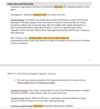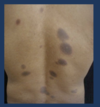Drug eruptions Flashcards
What are the seven “I’s” of a complete drug history?
Which medications do patients don’t usuallt talk about if not asked?
Remember the seven “I’s”:
- Instilled (eye drops, ear drops)
- Inhaled (steroids, beta andrenergic)
- Ingested (capsules, tablets, syrup)
- Inserted (suppositories)
- Injected (IM, IV)
- Incognito (herbs, non-traditional medicine, homeopathic, vitamins, over-the-counter)
- **Intermittent (patients may not reveal medications they take on an intermittent basis unless specifically asked)
Drug Timeline
What is the most important data if determining if the rash is medication-related?
For exanthematous drug eruptions, the initiation of the medication is often how many days before the rash?
- The most important data in determining if a rash is medication-related is its timing.
- By preparing a drug timeline, you can help find likely medication causes
- Start with the onset of the rash as Day 0, and work backwards and forwards
- For exanthematous drug eruptions, the initiation of the medication is often 7-10 days before the rash
–For repeat exposures, it may be much shorter
Timeline of Drug onsets
Which drug eruptions occur from minutes to hours?
Which drug eruptions occur from 1-2 days?
Which drug eruption occurs ususally in less than 4 days?
Which drug eruption occurs in average of 8 days (4-14 days)?
Which drug eruption could take months to show up (15-60 days)?

Example of a drug timeline:

Exanthematous Drug Eruption
It is limited the ______.
Where do lesions appear first and to where do they spread?
How long after the drug has been started do skin lessions appear?
After the drug is stopped, do the lesions persist?
- Exanthematous eruptions are the most common of all cutaneous drug eruptions (~90%).
- Limited to the skin
- Lesions initially appear on the trunk and spread centrifugally to the extremities in a symmetric fashion.
- Erythematous macules and papules, can coalesce into confluent patches/plaques.
- Pruritus (itching) and mild fever may be present.
- Skin lesions usually appear more than 2 days after the drug has been started, mainly around day 8-11, and occasionally persists several days after having stopped the drug.

Case 2
Important point to notice: she has the same lesion in the same location last year.


Fixed Drug Eruption

It is charaterized from the formation of a ________ that will recur at the same site with re-exposure to the drug.
What do they develop in the center?
- Adverse drug reaction characterized by the formation of a **solitary erythematous patch or plaque that will recur at the same site with re-exposure to the drug.
- May develop central ***vesicle/bullae

FD morphology:
What areas of the body are commonly affected?
From priviously sensitized individuals lesions may occur from ___ to ___ after ingesting the drug.
-Healed lesions are _____ with ______.
They are commonly ________ and can become large.

- Affects the mouth, genitalia, face, and acral areas
- In previously sensitized individuals, lesions may occur from 30 minutes to 8 hours after ingesting the drug.
- Early lesions are sharply demarcated erythematous macules.
- Lesions become edematous, forming a plaque, which may evolve to become a bulla and then an erosion.
- Healed lesions are dark brown** with **violet hue.
- Commonly solitary and can become large.
- May be multiple with random distribution.

Case 3:


ACUTE GENERALIZED EXANTHEMATOUS PUSTULOSIS (AGEP)
What are intertriginous areas?
Is there a lot of mucous involvement?
Characterized by elevated ______ in prticular______.
Systemic involvement with hepatic, renal, and __________ insufficiency.
What is often present?

- Typically small non-follicular pustules on an erythematous background that appear suddenly.
- Favor intertriginous areas (axillae, groin) at first, but then can becomes more widespread.
-Minimal to no mucous membrane involvement
- White blood cells are elevated (leukocytosis), in particular ***neutrophils (neutrophilia)
- Fever is often present
- Systemic involvement with hepatic, renal, or pulmonary insufficiency

Case 4:

Case 4:

Case 4:
When a patient presents to the clinci of rash and facial edema, order CBC and LTFs, why?


Drug induced hypersensitivity syndrome (DIHS)
Drug Induced Hypersensitivity Syndrome (DIHS)
What is another name of this?

Also: Drug Reaction with Eosinophilia and Systemic Symptoms – (DRESS), BUT EOSINOPHILS CAN BE LOW.
Typical symptoms:
–Fever
–Exanthem
–Facial swelling
–Lymphadenopathy
–Leukocytosis
–Transaminitis (~ 60%)
–Eosinophilia (~ 50%)
–Target, pustules, bullous lesions can be present
-**Hepatic, renal and cardiac involvement can occur

DIHS
Signs and symptoms typically begin in the _______ after start of medication.
What distinguishes DIHS from morbilliform?
What can be seen months later?
- Signs and symptoms typically begin in the 3rd week (2 -6 weeks) after start of the medication or after increasing the dose
- This distinguishes DIHS from benign morbilliform drug eruption, which appears in 7-10 days
- •Signs and symptoms may persist and recur for many weeks even after cessation of drug treatment
- Transient hypothyroidism can occur months later
- Fatality rate can be 10 - 30%

DIHS-Associated Myocarditis
Related to what type of cells?
What is severe acute necrotizing eosinophilic myocarditis.
- Common and under-recognized
- Acute eosinophilic myocarditis (hypersensitivity myocarditis)
–Non-specific ST,T wave changes, tachycardia, bump in Tn/CK-MB, systolic dysfunction
–Self limited
Acute necrotizing eosinophilic myocarditis
–More severe hypersensitivity myocarditis
–AMI symptoms with _normal coronary arteries**_
–Rapidly deteriorates, 3-4 day survival
•Can occur long after the original diagnosis
Medications implicated:
don’t memorze but pay attention so a few

Key points about DIHS

Case 5


Steven-Johnson Syndrome and TEN
Characterized by necrosis and detachment of ______ and ______.
They are acute life-treatening __________ reactions.

Stevens‐Johnson syndrome (SJS) and toxic epidermal necrolysis (TEN) are acute life‐threatening mucocutaneous reactions
‐ Characterized by extensive necrosis and detachment of the epidermis and mucosal surfaces.
‐ These two conditions are felt to represent similar processes but differ in severity based on body surface area (BSA)
‐ SJS/TEN is a dermatologic emergency**
‐ Mortality rate varies from 5‐12% for SJS and > 20% for TEN
‐ Increasing age, significant comorbid conditions, and greater extent of skin
involvement correlate with poor prognosis

What are the features that suggest a complicated drug eruption?
- Fever
- **Facial swelling
- Lymphadenopathy (swollen lymph nodes).
- Bullous or pustular lesions
- Threatened skin or a positive Nikolsky sign
**Mucosal involvement
**Systemic symptoms
-Laboratory abnormalities, including but not limited to peripheral eosinophilia, circulating atypical lymphocytes, elevated liver function tests, elevated creatinine.



